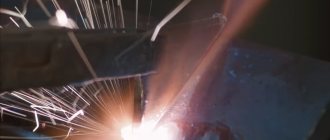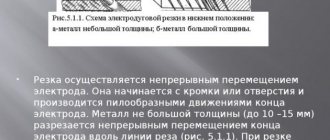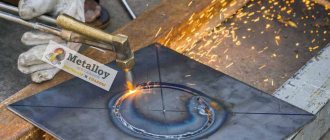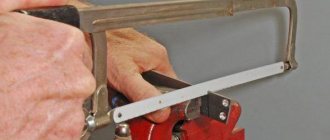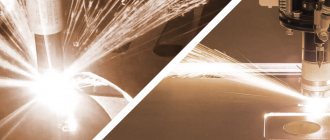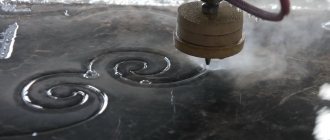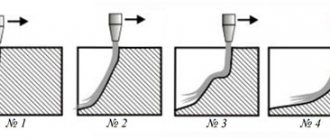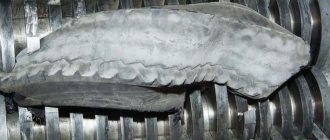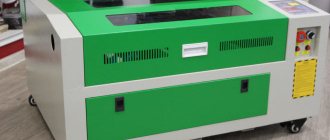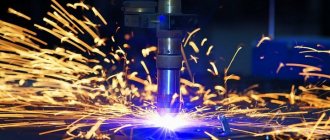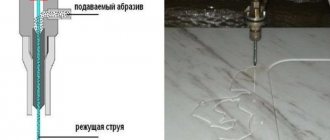Longitudinal cutting of sheet metal is carried out on a high-precision machine, and is the most important branch of industrial processing, dealing with the dissolution of metal sheets and metal rolls into strips and tapes of the required width for the subsequent manufacture of all kinds of metal products.
For many years, longitudinal cutting of metal has remained an important direction in the development of metalworking, which keeps the price of goods in Moscow and Russia within affordable limits.
Longitudinal cutting of various metals is a key stage in the manufacture of any metal parts, and today there are no alternative methods for effectively cutting metal.
Longitudinal cutting of sheet metal is practiced in the process of preparing tapes, strips and strips, which are separated from measured sections or rolled metal. Moreover, this procedure is carried out using special processing machines or complexes, the functioning of which is completely controlled by automation.
Only such equipment can provide both the required quality of the resulting workpieces and the required productivity of the cutting procedure.
Slitting Equipment
It is possible to implement the above methods on lines oriented towards large-scale production, small machines and high-performance units.
Each type of equipment is oriented toward a specific cutting pattern and has its own disadvantages and advantages. Moreover, the choice of a specific unit or a specific cutting model is associated with a set of tasks that can be solved with their help.
Metal slitting machine
This machine is a type of cutting equipment and is used for transverse or longitudinal cutting of metal measuring sheets. That is, it is not the roll that is loaded into the feed rollers of the machine, but a sheet prepared in advance, which is then transported to the cutting zone.
Disc shears, which are used in machine tools and intended for such a procedure as longitudinal cutting of metal , can easily separate structural polymers, thick cardboard, sheet aluminum, copper, and sheet steel into strips of the required thickness.
Moreover, the cutting tool is fixed to the pressure shaft using screws. The width of the stripes can be adjusted either manually or automatically. More advanced models are not limited to longitudinal cutting only - such units have a head with cutting rollers mounted on screw shafts, which perfectly ensures transverse cutting of metal.
In addition, in addition to cutting, such machines can be equipped with a block for applying a protective film, which is glued to the sheet before the material is divided into strips.
Process technology
The beginning of the technological process is that you first need to cut the strip to a certain length. Then, current is connected to the incised areas.
The magnitude of the current should ensure local heating of the strip in the place where the melting temperature of the metal separates.
The magnitude of the current depends on the thickness of the strip, the physicochemical properties of the metal and the frequency of the supplied electric current.
Due to local heating of the strip at the point of distribution to the melting temperature of the metal, a reduction in cutting force is observed.
This is due to the fact that the mechanical properties of the metal begin to decrease at the point of separation to the melting point.
Video:
Thanks to this, the knives can be replaced with a pair of separating rollers made of carbon steel.
Longitudinal transverse cutting of metal involves the formation of new, narrower strips that do not have burrs and are rounded.
Thanks to this, all the requirements that apply to workpieces for the manufacture of bent profiles of welded straight-seam pipes are met.
The presented process technology contributes to obtaining high quality longitudinal cutting of strips using the same tool.
In addition, such strips do not require additional operations and equipment, which significantly reduces costs.
IMPORTANT TO KNOW: Methods of shaped metal cutting
Slitting line for rolled and sheet metal
The cutting line is used in both large-scale and small-scale production. Such a system is characterized by high performance. With its help, sheet metal can be cut into blanks of various widths and lengths. As a result, such cutting systems are used for the production of dimensional blanks for stamping, for the pipe industry, semi-finished products (strips) and other products that are obtained from rolled sheets.
The cutting line for sheet metal or other material consists of the following mechanisms and components:
- A machine is a cutting unit used for longitudinal cutting of rolled metal. Moreover, a device is built into the cutting unit in high-speed lines that increases the plasticity of the metal due to heating by induction currents.
- Feeding ox systems - a conveyor, with the help of which the roll is unwinded and subsequently transported to the cutting zone of the sheet itself.
- A hopper where a roll of material to be cut is stored on a shaft.
- In addition, almost any line is equipped, in addition to a longitudinal cutting block, with a transverse mechanism, which is designed to separate the metal being processed.
- Moreover, high-speed processing forces the control system to build line operation based on numerical program control blocks.
And after the sheet cutting procedure is completed, the softened edges should be further processed with induction currents, removing residual stress in the metal structure.
The main advantage of such lines is the high processing speed and standard-size range of workpieces produced with their help. After all, with circular knives, the cutting unit can be adjusted to any width, and the transverse system can move at high speed, cutting rectangular or square workpieces from belts.
Rolled metal slitting unit
The units are fully automated cutting lines for rolled metal. Only in large-scale production are such devices used to produce large batches of similar products.
The unit for cutting rolled metal consists of the following blocks:
- Drum unloading systems, which remove a roll of the required width from the drum.
- A drum onto which the finished strips are wound to the required width.
- A loop compensator, its task is to slow down the speed of movement of the cut strips.
- A longitudinal cutting unit in which the sheet is divided into strips of the required parameters using circular knives.
- A pre-treatment complex that heats up the sheet and cuts the edges before entering the cutting zone. Moreover, cutting waste is wound onto separate coils.
- A trolley with a hopper is a conveyor that is mounted on rails. The trolley moves along the rails in the direction opposite to the direction of sheet metal supply; the sheet is unwound and loaded into the transport pressure rollers. Rollers hold the sheet from winding into a roll and then roll the material. This scheme makes it possible to increase the feed rate of material into the cutting zone. In addition, in this case the trolley acts as the engine, and the transport sheets only simply position the sheet.
Of course, these units are only automatically controlled. And thus, the resulting cut rolls of strips can be further moved to less productive machines and lines for subsequent transverse or longitudinal cutting.
Smooth sheet
Specifications
| Standard galvanized sheet | |
| Length: 2,500 mm | |
| Width: 1,250 mm | |
| Thickness: 0.4mm to 2.5mm | |
| Length: 2,000 mm | |
| Width: 1,000 mm | |
| Thickness: 0.4mm to 0.7mm | |
| Custom Galvanized Sheet | |
| Length according to customer dimensions: from 500 mm to 6,000 mm | |
| Cutting accuracy: +/-2 mm | |
| Thickness: 0.4mm to 1.0mm | |
| Maps and stripes | |
| Length and width: according to customer sizes | |
| Cutting accuracy: +/-1 mm | |
| Thickness: 0.3mm to 2.5mm | |
Cross-cutting of rolled steel into sheets is carried out in standard sizes: width - 1250 mm, length - 2500 mm, thickness from 0.4 mm to 2.5 mm; width - 1000 mm, length - 2000 mm, thickness from 0.4 mm to 0.7 mm. And non-standard sizes: length from 500 mm to 6000 mm, thickness from 0.4 mm to 1.0 mm, cutting accuracy +/- 2 mm. Cutting into cards and strips is possible: width and length according to customer dimensions, thickness from 0.3 mm to 2.5 mm, cutting accuracy +/- 1 mm.
Features of working with Metalmos
Longitudinal-transverse cutting is performed on modern machines, which guarantees quality. The company makes every effort to ensure that the result of the work meets the client's expectations. To arrange a cutting service, just call the company’s office or leave a request on the website.
To ensure high quality and durability of products, we purchase raw materials from the largest manufacturers of rolled steel in Russia: OJSC Novolipetsk Iron and Steel Works, OJSC Severstal, PJSC Magnitogorsk Iron and Steel Works. All products are certified and comply with GOST standards.
Each client is provided with an individual specialist with whom you can discuss all the nuances of the order. To calculate the cost, send a request by email or use the form below. We are waiting for your call by phone number 8-495-118-36-88!
Working with us, you can be confident in the quality and efficiency of cutting.
There are several main types of longitudinal cutting of materials:
- Artistic cutting. This type of cutting is mainly used to make decorative items for apartments, gardens or houses. This method creates various grilles, lanterns, stairs with railings, wickets and gates, as well as various other fences and decorations for houses and plots. Decorative frames and logos are often produced. Using various saws, any type of material can be cut;
- Laser cutting. This is a more improved version of metal cutting. After all, with the help of a laser you can significantly speed up the work process, increase cutting accuracy, reduce the percentage of defects, which helps to increase labor productivity. When laser cutting material, there is no dynamic effect on the workpiece, which provides a chance to process various types of metals.
- Modern laser equipment has a built-in CNC. The sheets are fixed on a special desktop, and then certain work formulas are set using a computer program. The portal with the laser head begins to move using stepper motors;
- Figure cutting. This cutting method is used for more complex products. For example, patterns are made using this type of cutting. Contours are marked on the sheet, and the laser moves along them. The product will not be able to deform, since there is no mechanical effect on the metal;
- Contour cutting. In this method, there is no need to perform subsequent additional sanding of the product. The diameter of the laser beam does not go beyond the limit - 4 millimeters. It can be used to cut difficult designs. This method is very suitable for longitudinal and transverse cutting of metal rolls.
Methods for cutting rolled metal
One of the main technological fundamentals is cutting of rolled material. It can be performed using transverse, longitudinal and longitudinal-transverse cutting.
Using the longitudinal cutting method, you can increase the efficiency of the workflow in processing sheets of rolled metal. This is the reason why automated cutting installations are used in serial and mass production.
Cross thread
Equipment cutting metal sheets is capable of:
- Divide rolls into equal sections for further production and storage.
- Create single copies with the same parameters for post-processing.
Such installations are optimal for production lines for the production of metal tiles, profiled sheets, etc.
Longitudinal-transverse thread
The technology of threading in the longitudinal-transverse direction combines the characteristics of several installations at once. The system operates in automatic mode. Using this equipment, metal is cut in the form of sheets or rolls.
Services provided
Specialists have prepared for operation a production line for dissolving metal in rolls into tapes and strips. We accept orders for transverse and longitudinal cutting of sheets and rolls of metal in Moscow and the region. Well-developed cutting technology allows you to cut metal into strips and create high-quality products in which there is no residual stress (no twisting or crescent effect).
In addition to high-quality products at an affordable price, our customers receive the following advantages:
- The ability to personally specify the dimensions of the tape or strip to be cut. In accordance with GOST 503-81, a fixed size of standard cold-rolled strip is provided, however, our customers can order any required size.
- Possibility of ordering the dissolution of metal into strips or tapes from our raw materials. This is beneficial for small order quantities. In this case, you will not have problems where to buy blanks and how to transport them.
- Possibility of additional processing of metal. At our enterprise you can not only use the metal cutting service, but also process it or make perforations of blanks.
- With us you can place your order in a few minutes and receive fast delivery.
